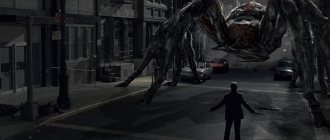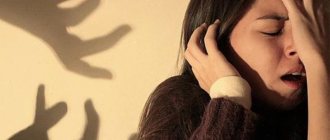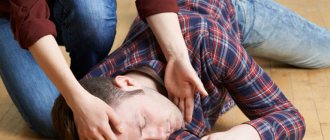- October 6, 2018
- Manias and Phobias
- Natalie Lynn
Insectophobia, also known as entomophobia, literally translates as fear of insects. This phobia is one of the subtypes of zoophobia and, in turn, is divided into several subtypes, for example, apiophobia - fear of bees, arachnophobia - fear of spiders, myrmecophobia - fear of ants, acarophobia - fear of ticks. Therefore, if you want to know what the fear of insects is called, you should clarify which species you are interested in.
The review will talk about insectophobia. It refers to an irrational fear of some or all types of insects. Fear mainly arises in humans due to aversion towards various insects due to their shape, color and also because they spread many diseases.
A phobia that originates in a person makes his life very uncomfortable. An insectophobe may not even leave the house, for fear of noticing any insect outside of it. Fear also gives rise to “delusional parasitosis,” when the patient begins to experience sensations such as tingling, itching, crawling on his skin, and react accordingly to them - try to remove a non-existent insect from his body, wash it off or scratch the skin until it bleeds, which, in in turn, can lead to infection. A person suffering from insectophobia may also develop OCD, or obsessive-compulsive disorder. It creates a desire to constantly clean the living space and complicates a person’s mental and physical condition.
Causes of insectophobia
Why are people afraid of insects? There are many reasons that can cause insectophobia, or fear of insects, in a person. The reasons can be divided into two main categories.
Objective factors:
- Lived experience. It often happens that a person develops a disease of fear of insects after being bitten by a bee, mosquito, etc. A similar experience experienced in childhood can lead to psychological trauma, which develops into insectophobia.
- Imitation of others. If there is a person in the family who suffers from insectophobia, the child can learn from him not only to be wary of insects, but also to reinforce the fear, degenerating it into a full-fledged phobia.
- Medical problems. If you have been through a traumatic experience in your personal life due to loss of someone or divorce, the level of stress can create fear in you. Poor mental health, mental retardation and anxiety problems, or poor physical condition due to hyperthyroidism, folate and thiamine deficiency can also contribute to the onset of a phobia. Diseases such as syphilis, meningitis, cirrhosis can give rise to a phobia in you. Schizophrenia is another significant reason for the development of a phobia.
Environment. A person may feel like something is crawling on their body, but this sensation may be due to skin irritation caused by static electricity, pollen deposits and allergens on the pores of the skin or products containing, for example, formaldehyde.
Contrived factors:
- Thoughts of harm. Many patients constantly think about how certain insects can harm them: whether their bites are poisonous, whether they carry infections, and the like. Such thoughts, which may initially be quite rational, gradually become obsessive and contribute to the formation of insectophobia.
- Fantasy. If the previous point was based on objective information and the macrocosm, then in this case the whole problem lies in the patient’s wild imagination. Without any special knowledge about insects, a person imagines them as terrible monsters capable of causing him great harm.
- Literature, cinema, computer games, etc. Images depicting terrible insects, which often do not correspond to reality, an artistically exaggerated description of harm contribute to the formation of insectophobia,
Some facts
There are peoples who today live in nature, far from civilization. They are constantly in contact with insects of different species and are not afraid of them. There are several reasons for this:
- Insects do not feed on people; they have no reason to attack. (Exception: mosquitoes and ticks).
- After a tick bite, all you need to do is go to a medical center, where they will help you.
- Mosquito bites do not spread AIDS. Not a single case has been recorded, despite the fact that the disease is very common.
- The bee dies after stinging you. She will only attack as a last resort. So don't be afraid of bees. Be calm. Move away. It would be enough.
- Everyone is afraid of spiders. But few people know that even tarantulas do not have deadly poison. In many species, only females are poisonous during the breeding season. This dramatically reduces the chances of death. Not all venomous spiders are poisonous enough to kill a person. It is enough to study the information and know what measures to take in case of a bite.
Now think about it, is your fear justified?
Signs and symptoms
Symptoms that may indicate entomophobia or insectophobia:
- Constant complaints of insect bites are the main symptom of insectophobia, that is, a phobia such as fear of insects.
- Reclusion.
- Reading about insects to see if fear is rational.
- Obesity.
- Frequent visits to doctors due to skin problems.
- When thinking about insects, physical tension appears, expressed in symptoms such as shortness of breath, nausea, and vomiting.
- A panic attack at the sight of an insect is also a sign of insectophobia.
- Isolation from society.
The symptoms are so common that a person often does not realize that they are developing a phobia - the fear of insects. The main symptoms of any phobia are:
- Panic when confronted with the cause of fear or even at the thought of the source of fear.
- The desire not to leave the house in order to avoid confrontation with the source of fear.
- A feeling of powerlessness due to the fact that a person cannot control fear, even knowing that it is irrational.
- The children start crying.
- Development of physical symptoms such as inability to breathe, sweating, and vomiting.
Somatic manifestations:
- dilated pupils,
- muscle hypertonicity, trembling of arms and legs,
- increased heart rate,
- paleness/redness of the skin,
- psychomotor agitation,
- changes in blood pressure,
- profuse sweating,
- nausea,
- difficulty breathing, shortness of breath,
- weakness, faintness;
- panic attacks.
An insectophobe has a desire to run away from the insect or deal with it. He loses the ability to think rationally and in this state can harm himself and others.
Tests for diagnosing insectophobia
Currently, there are no proper tests to identify a specific phobia, so doctors turn to the Diagnostic and Statistical Manual of Mental Disorders, published by the American Psychiatric Association, to test various criteria for identifying insectophobia. The guideline also suggests the type of treatment that can be administered to the patient. During therapy sessions, you will be asked various questions, and your response to them will serve to determine the phobia. Your medical and psychological history and heredity will also help doctors in the identification process.
The main criteria that help diagnose insectophobia are:
- A feeling of intense fear and irritation when the patient notices an insect or even sees a picture of it.
- Fear even at the thought of insects.
- Avoiding encounters with any insects or even viewing images of insects.
- Avoidance of all types of social activities that occur outside the home so that the patient can avoid encounters with insects. When an insect approaches a person, he noticeably tenses up.
- Symptoms of the phobia continue for more than 6 months.
It is worth noting that fear of insects is inherent in most people, but in order to determine which fear of insects is a phobia in its pure form, it is still worth contacting a specialist. He is the one who will help you understand and establish an accurate diagnosis.
First aid for panic attacks
In a moment of panic, a person thinks that he will suffocate, die, or go crazy. Somatic symptoms include ringing in the ears, dizziness, and nausea. It is better to entrust the treatment of panic attacks to a specialist; in this case, drug treatment is indicated. But it's important to know what you can do if a panic attack takes you by surprise.
First aid for a panic attack:
- focus on any object, this is necessary to switch attention;
- take several deep, long breaths in and out, this is necessary to normalize breathing and heartbeat.
You can use a paper bag. Take one deep breath and after eight seconds exhale slowly into the bag, repeat the procedure for five minutes.
Exercise and communication with loved ones are indicated as additional methods and means of prevention. Try to spend less time alone, especially before an upcoming meeting with the subject of fear.
Independent actions
If the case is not advanced and your phobia is at the initial stage of development, it is important to understand what exactly is bothering you - what insects and possible causes of fear. By answering these questions yourself, you can choose how to deal with your fear of insects.
- If you are afraid of the unknown or there is no information about this or that representative of the macrocosm, you should read an encyclopedia about insects, study pictures, detailed descriptions. You can also watch documentaries, just make sure (ask someone to watch the film in advance) that it does not contain scenes that frighten you, for example, contact of insects with people, insect attacks on humans, etc. This method is suitable for both children, as well as for adults.
- If the cause of your fear is a feature film, you should watch it again, not forgetting that everything that happens on the screen is fiction. When using this method with children to help them get rid of their fear of insects, think carefully about the approach, otherwise the situation may only get worse.
- If insects are simply unpleasant to you, for no apparent reason, consider buying photo wallpaper depicting representatives of the macrocosm. Souvenirs and accessories will also help - having gotten used to seeing only decorations in an insect, a person will gradually forget about fear.
Fear of infection
In many cases of entomophobia, the patient is afraid of becoming infested with insects. Many insects, such as cockroaches and flies, carry diseases. However, people with infection phobias take reasonable caution and precision to extremes. In addition, there is disgust, a reaction that often causes symptoms of anxiety. A variety of studies conducted in the 2000s have shown that we react more strongly to creatures we find disgusting than to animals that may be more dangerous in nature. This may be an evolutionary response to our ancestors' misunderstanding of disease prevention.
Treatment of insectophobia
If the methods listed above did not help you cope with the problem, be sure to seek help from a professional.
Entomophobia, or insectophobia - as the fear of insects is called - is often mistakenly considered a mental illness. Because this phobia is not well documented in the list of similar disorders, doctors are often unable to identify it. The patient remains without proper treatment for a long time. Therefore, the diagnosis of phobia is very important and multidisciplinary approaches should be taken.
Some therapeutic treatments for insect phobia along with prescribed medications allow the patient to remain calm and in control. Often during psychotherapy, an entomologist is brought in for consultation to help the patient understand that his fear is irrational.
Training
The training includes exercises aimed at combating arachnophobia. They can be performed under the supervision of specialists or at home. Let's take a closer look at how to get rid of arachnophobia yourself.
Exercise to distance yourself from fear
To suppress fear, you need to master relaxation techniques. The exercises involve complete detachment from the object of the phobia and denial of its significance for the individual. To do this, it is necessary to take into account the characteristics of the human psyche.
People suffering from a phobia of spiders are more afraid of spiders in their own apartment . Fear is often associated with embellishing reality for various reasons. A person can cope with arachnophobia by mentally shrinking an insect to a small point.
Exercise getting rid of your spider
A popular method of treating arachnophobia is a graphic image of an insect. A person who is afraid of spiders is asked to draw a large specimen on paper and destroy the drawing with his own hands.
After this, the individual needs to draw small individuals. Training therapy continues until the person gets rid of his fears.
Desensitization, or exposure therapy, to treat insectophobia
Desensitization or exposure therapy to treat insectophobia helps overcome fear by exposing the patient to the object of fear. For example, the first images of insects are shown so that the patient can influence and reduce his level of anxiety. Slowly, as the patient begins to understand that not all insects are harmful, he is taken out into the garden where he may come into contact with flies or bedbugs.
Medicines for the treatment of insectophobia
Although medications cannot reduce insectophobia, they can help you control the physical symptoms that arise from the phobia.
- Antidepressants are called serotonin reuptake inhibitors, which control your mood by working as neurotransmitters in your brain. Antidepressants are prescribed according to your condition.
- Sedatives for insectophobia are those medications that are also known as benzodiazepines and help calm your nerves and make you less anxious. But at the same time, you should be careful while taking these pills as you may develop addiction and there may also be adverse effects if you take alcohol.
- Beta blocker medications block the stimulating sensations you experience due to entomophobia. The medicine also reduces heart rate caused by anxiety. A small amount may improve your condition for a while.
Risk factors
There are several factors that may put you at risk of developing a phobia:
- If you notice that anyone close to you, such as father, mother, brother, etc., suffers from insectophobia, you risk developing this fear in yourself as well.
- If you have experienced a traumatic incident in the past, you may develop fear of the source.
- Specific phobias develop even at the age of 10, so you become unable to interact with people.
Complications
A phobia that bothers someone and causes serious problems in their life may not seem like a concern to others. A patient suffering from insectophobia may have many complications, such as:
- Avoiding any social interaction because of the thought that people might laugh at him. This behavior can lead to reclusiveness and loneliness.
- The complication of insectophobia leads to clinical depression or develops anxiety disorders.
- Substance abuse to cope with stress caused by fear.











